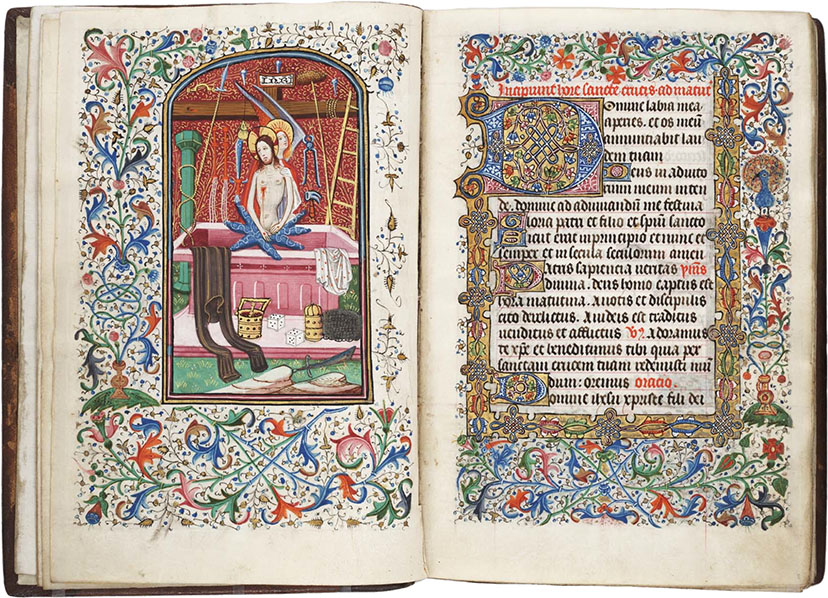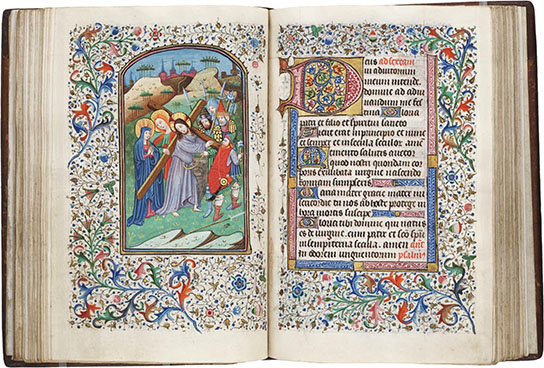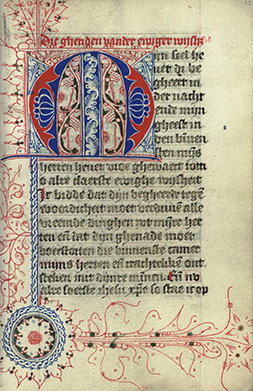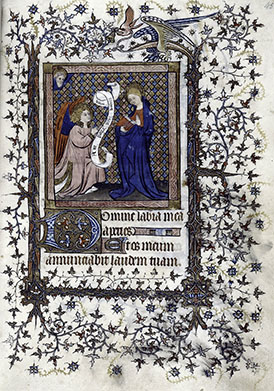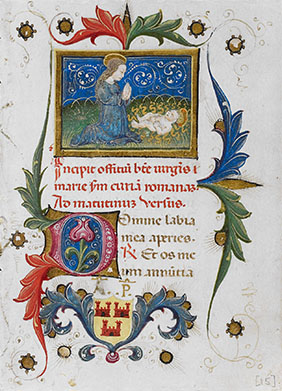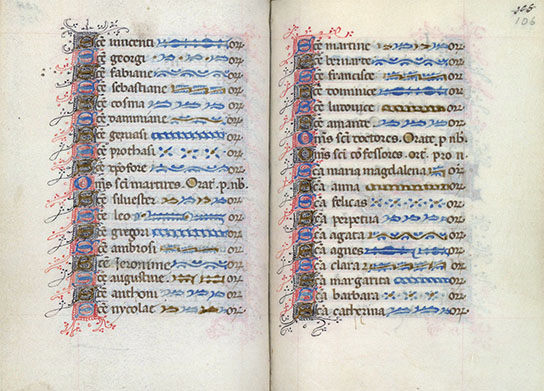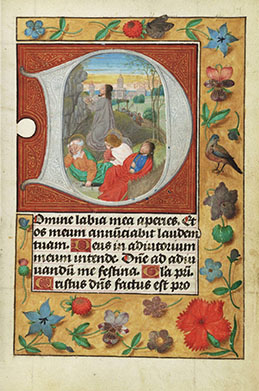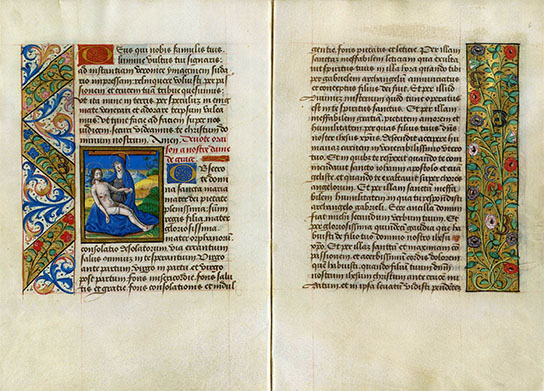53
Books of Hours
This two-page spread, folios 7v and 8r, are from a Book of Hours produced in Bruges, Flanders, ca.1425. It includes a miniature showing the instruments of the Passion of Christ, complete floral borders, elaborately historiated initials in descending sizes, and colored keywords. Along with gold leaf (which appears later in the manuscript), this is pretty much every device in the Book of Hours’ scribes toolbox, or arsenal, or whatever metaphor you choose.
By the 20th century this manuscript was in the possession of Baroness Angela Georgina Burdett-Coutts, who at one time was the richest woman in England. It was inherited by her husband and later sold by Sotheby's to Maggs Brothers Bookseller of London. Maggs Brothers, in turn, sold it to the Philadelphia collector John Frederick Lewis in 1923 and he donated the manuscript to the Free Library of Philadelphia in 1935.
Christ Bearing the Cross, ff. 55v–56r. Philadelphia1
After the Fourth Lateran Council (1215) there was a growing desire by the laity to more closely imitate the devotions of the monastic monks and nuns, but the psalter or the breviary were entirely too complex and variable for your average Joe (or more typically, Jane).2 What was needed was a “Breviary for Dummies,”3 and this would be the The Book of Hours.
A Book of Hours was intended as a small, and personal, book of devotion. Although the contents varied to some extent, generally it began with a liturgical calendar followed by extracts from the four gospels, the Hours of the Virgin, the Hours of the Cross and the Hours of the Holy Spirit. The book concluded with the Office for the Dead, the Seven Penitential Psalms, the Litanies, and prayers to the Virgin and other saints.4
Although less expensive than, e.g., a Bible, a Book of Hours was still within reach of only the wealthy. Early examples from the 14th century are comparatively plain, but the amount of work and expense that went into their creation is still rather apparent:
Netherlands, 14th century. UT Austin
England, 14th century. Harvard
The popularity of the Book of Hours reached its peak by the middle of the 15th century. Nobility and the wealthy were commissioning increasingly deluxe versions of the manuscript; versions that required not only a scribe (or several) but also illuminators and artists for the extravagant miniatures (often including the family’s coat-of-arms), illumination and decoration.
The Annunciation, f. 23r. France, ca.1400. NYPL
Virgin and Child, uncollated. Italy, ca.1450. Grolier Club
Litany, ff. 105v–106r. Bruges, ca.1485. UC Berkeley
Gethsemene, f. 14r. Flanders, ca.1485. UT Austin
The Virgin Mary, ff. 5v–6r. Rouen, ca.1500. Det Kongelige Bibliotek
Jesus on the Mount of Olives, f. 1r. France, ca.1475. Columbia
The Book of Hours was produced throughout Western Europe, but it was especially popular in France and the Low countries. By ca.1430 stationers in Paris and Ghent (among others) began to mass-produce the books, sometimes using tipped-in plates, for “middling merchants and local gentry, people with social pretensions who would be attracted by something which looked more expensive than it really was.”
The Book of Hours was by far the most commonly produced book of the late middle ages. Even after the advent of mechanical type it was still commissioned as a luxury item for the wealthy and powerful, but by the middle of the 16th century it had been mostly replaced by a simpler, and much less costly devotion – praying the rosary.
The Legend of the Three Living and the Three Dead, f. 113r. Bourges, ca.1500. Philadelphia
1. Most, but not all, of these images are from the holding institution via Columbia University’s spectacularly wonderful Digital Scriptorium.
2. Or, to be more historically accurate: John and Mary.
3. A title that you would think actually exists, but sadly dosen’t. There is, however, this: Nugent, Madeline Pecora. The Divine Office for Dodos: A Step by Step Guide to Praying the Liturgy of the Hours. Totowa, New Jersey: Catholic Book Company, 2008. Let me know how this works out for you.
4. For more information on the Book of Hours, including a complete translation of a later English Primer version, see the appropriately named Hypertext Book of Hours.
18 Jan 2010 ‧ Typographia Historia
